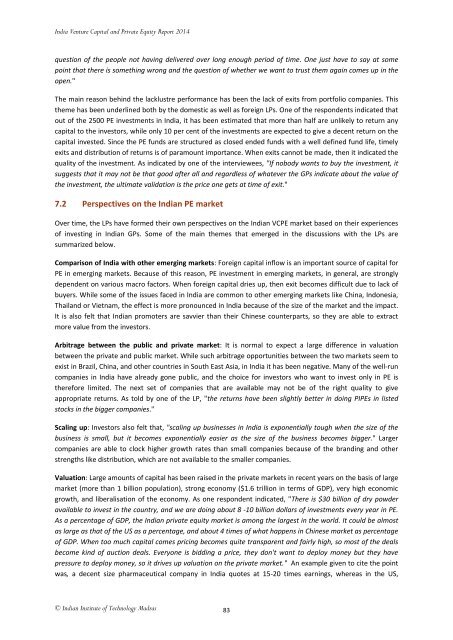Past Reports
2014vcpa
2014vcpa
Create successful ePaper yourself
Turn your PDF publications into a flip-book with our unique Google optimized e-Paper software.
India Venture Capital and Private Equity Report 2014<br />
question of the people not having delivered over long enough period of time. One just have to say at some<br />
point that there is something wrong and the question of whether we want to trust them again comes up in the<br />
open."<br />
The main reason behind the lacklustre performance has been the lack of exits from portfolio companies. This<br />
theme has been underlined both by the domestic as well as foreign LPs. One of the respondents indicated that<br />
out of the 2500 PE investments in India, it has been estimated that more than half are unlikely to return any<br />
capital to the investors, while only 10 per cent of the investments are expected to give a decent return on the<br />
capital invested. Since the PE funds are structured as closed ended funds with a well defined fund life, timely<br />
exits and distribution of returns is of paramount importance. When exits cannot be made, then it indicated the<br />
quality of the investment. As indicated by one of the interviewees, "If nobody wants to buy the investment, it<br />
suggests that it may not be that good after all and regardless of whatever the GPs indicate about the value of<br />
the investment, the ultimate validation is the price one gets at time of exit."<br />
7.2 Perspectives on the Indian PE market<br />
Over time, the LPs have formed their own perspectives on the Indian VCPE market based on their experiences<br />
of investing in Indian GPs. Some of the main themes that emerged in the discussions with the LPs are<br />
summarized below.<br />
Comparison of India with other emerging markets: Foreign capital inflow is an important source of capital for<br />
PE in emerging markets. Because of this reason, PE investment in emerging markets, in general, are strongly<br />
dependent on various macro factors. When foreign capital dries up, then exit becomes difficult due to lack of<br />
buyers. While some of the issues faced in India are common to other emerging markets like China, Indonesia,<br />
Thailand or Vietnam, the effect is more pronounced in India because of the size of the market and the impact.<br />
It is also felt that Indian promoters are savvier than their Chinese counterparts, so they are able to extract<br />
more value from the investors.<br />
Arbitrage between the public and private market: It is normal to expect a large difference in valuation<br />
between the private and public market. While such arbitrage opportunities between the two markets seem to<br />
exist in Brazil, China, and other countries in South East Asia, in India it has been negative. Many of the well-run<br />
companies in India have already gone public, and the choice for investors who want to invest only in PE is<br />
therefore limited. The next set of companies that are available may not be of the right quality to give<br />
appropriate returns. As told by one of the LP, "the returns have been slightly better in doing PIPEs in listed<br />
stocks in the bigger companies."<br />
Scaling up: Investors also felt that, "scaling up businesses in India is exponentially tough when the size of the<br />
business is small, but it becomes exponentially easier as the size of the business becomes bigger." Larger<br />
companies are able to clock higher growth rates than small companies because of the branding and other<br />
strengths like distribution, which are not available to the smaller companies.<br />
Valuation: Large amounts of capital has been raised in the private markets in recent years on the basis of large<br />
market (more than 1 billion population), strong economy ($1.6 trillion in terms of GDP), very high economic<br />
growth, and liberalisation of the economy. As one respondent indicated, "There is $30 billion of dry powder<br />
available to invest in the country, and we are doing about 8 -10 billion dollars of investments every year in PE.<br />
As a percentage of GDP, the Indian private equity market is among the largest in the world. It could be almost<br />
as large as that of the US as a percentage, and about 4 times of what happens in Chinese market as percentage<br />
of GDP. When too much capital comes pricing becomes quite transparent and fairly high, so most of the deals<br />
become kind of auction deals. Everyone is bidding a price, they don't want to deploy money but they have<br />
pressure to deploy money, so it drives up valuation on the private market." An example given to cite the point<br />
was, a decent size pharmaceutical company in India quotes at 15-20 times earnings, whereas in the US,<br />
© Indian Institute of Technology Madras<br />
83


